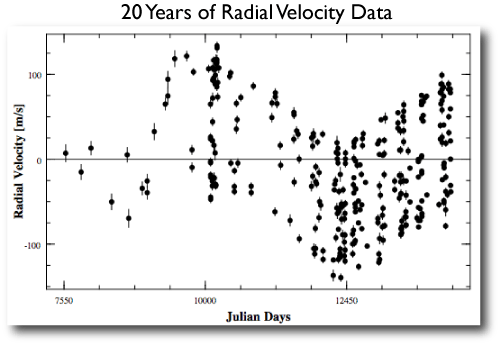
Image Source.
Here’s a development that systemic regulars will find interesting! In a press release today, came announcement of the detection of a fifth planet in the 55 Cancri system (paper here). The new planet has an Msin(i) of 0.144 Jupiter masses, a 260-day orbital period and a low eccentricity. The detection is based on a really amazing set of additions to the Lick and Keck radial velocities:

For background on the 55 Cancri system, check out this oklo.org post from December 2005.
The outer four planets in the 55 Cancri system all have fairly low eccentricities in the new five-planet model. This leads to a diminished importance for planet-planet interactions, but nevertheless, the system does require a fully integrated fit. Deviations between the Keplerian and integrated models arise primarily from the orbital precessions of planets b, c, and e that occur during the long time frame spanned by the radial velocity observations.
Eugenio has added the velocities onto a fully updated version of the downloadable systemic console. The new version of the console adds a wide variety of new features (including dynamical transit timing) that were formerly available only on the unstable distribution. Check it out, and see the latest news on the console change log and the backend discussion forum. Over the next month, we’ll be talking in detail about the new features on the updated console.
Very shortly, a new entries corresponding to the updated 55 Cancri data sets will be added to the “Real Stars” catalog on the systemic backend. I’ll then upload my baseline integrated 5-planet fit to the joint Keck-Lick data set. I’m almost certain that with some computational work, this baseline model can be improved. Such a task is not for the squeamish, however. Obtaining self-consistent 6-body models to the 55 Cancri data set is a formidable computational task for the console. There are 29 parameters to vary (if the Lick, Keck, ELODIE and HET radial velocity data sets are all included). The inner planet orbits every 2.79 days, and the data spans nearly two decades. Fortunately, Hermite integration is now available on the console. Hermite integration speeds things up by roughly a factor of ten in comparison to Runge Kutta integration.
There have been hints of the 260-day planet for a number of years now because it presents a clear peak in the residuals periodogram. After the 2004 announcement of planet “e” in its short-period 2.8 day orbit, Jack Wisdom of MIT circulated a paper that argued against the existence of planet “e”, and simultaneously argued that there was evidence for a 260-day planet in the data available at that time. More recently, a number of very nice fully self consistent fits to the available data have been submitted to the backend (by, e.g., users thiessen, EricFDiaz, and flanker). Their fits all contain both the 2.8 day and the 260-day planets, and happily, are fully consistent with the new system configuration based on the updated velocities. Congratulations, guys!
Interestingly, the best available self-consistent fits to the system indicate that planets b and c do not have any of the 3:1 resonant arguments in libration. It will be interesting to see whether this continues to be the case as the new fits roll into the systemic backend.

Fantastic result, but it’s a pity this rules out terrestrial-mass planets in the habitable zone.
Given the importance of planet-planet interactions over the timescale of the data, perhaps it would be useful to also have radial velocity datasets scaled up to account for the astrometric inclination measurements of the system, to see what effect that has on the solution.
Further question comes to mind: have radial velocity measurements of the companion star to 55 Cancri been made? Are there any constraints on planets around it?
@Andy: it does not rule out terrestrial-mass moons, however, in the habitable zone :)
Thanks, Greg.
Best,
Eric
devicerandom: it does if the relationship between the mass of a gas giant and the mass of its moon system holds in the 55 Cancri system as well as in our own. Keeping the moon:planet mass ratio the same, scaling down Titan or scaling up Triton yields a moon of about a lunar mass. Scaling Ganymede or Titania gives rather smaller moons.
I wonder if the Trojan points are stable?
So, what are the odds of finding a more than one planet around the same star using light curves, say, with using the COROT probe?
I reacted exactly as Andy did when I saw this news the other day – drat, there goes that lovely hypothetical Earth twin that was supposed to be orbiting around 1 AU. And yes, the new planet seems too small to have big moons – although in that regard, nobody has really studied how satellite systems might form around giant planets that migrate into Earthlike orbits. Could all the rocky planetesimals in that region of the disk alter the mass ratio between planet and moon? (That is, if Planet f really did migrate there – Fischer & company seem to leave open the possibility of in situ formation.)
It’ll be interesting to see what evolutionary models the theoreticians can concoct now that 55 Cancri’s inner system architecture is so well constrained.
And now that we know that the system’s habitable zone is full, are there any other good candidate systems with a Jupiter analog and a giant-free HZ? The likeliest one I know of is HD 154345, which is only a little farther away than 55 Cancri. Exoplanets.org initially listed it with a high orbital eccentricity and a very large semimajor axis, but they currently give e = 0.05 and a = 4.17 AU. However, I don’t think there’s even a discovery paper on that one. I’m really curious to know more, if there’s any more to know.
Pingback: systemic - Just like in 1846